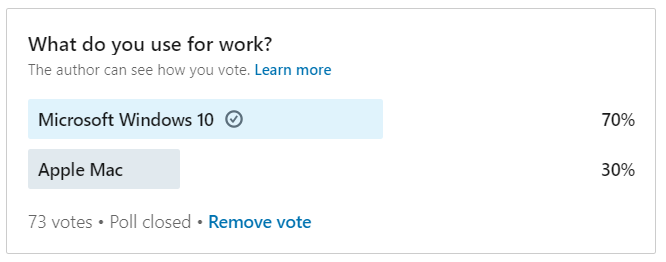
Executive Summary
- When it comes to workplace computing, businesses have plenty of choice, but there are two dominant platforms: Mac or PC (Windows).
- According to a recent poll we held on LinkedIn, 70% of business users worked on Windows, while 30% were using a Mac.
- In this article, we’ll outline the benefits of both Windows and Mac for business users to help you decide which is best for your small business.
Introduction
Some debates rage on for a lifetime.
Tea vs. coffee. Salty vs. sweet. Marvel vs. D.C. And, of course, Mac vs. PC.
If you’re a small business owner, or you’re responsible for deciding on the computing infrastructure for your company, picking a side can feel like a daunting task. Ask ten people and you’ll get ten different responses – all with well-reasoned and logical explanations. In fact, we did ask more than ten people. Our founder, James Craddock, held a poll on LinkedIn asking which platform business owners used, and the results are fascinating.
Drumroll, please…
- 70% use Windows machines for their business computing.
- 30% use a Mac.

It’s clear there’s still something of a split, even if Windows tends to have the edge. So how are you supposed to make such a bug decision for your business?
Don’t worry – Get Support is here to help.
With decades of experience on both sides of this argument, we’re well-placed to advise you on what both PC and Mac does well – and why it might work for your business.
Part 1: Why choose Apple Mac for your business?
Let’s begin with what appears to be the underdog in our story: the Apple Mac.
Known the world over for its flashy focus on aesthetics and a closed ecosystem which (allegedly) increases IT security, Macs are certainly becoming more popular for business users – but should you invest?
Here are a few reasons why Mac might work for you.
#1: Simplicity and ease-of-use
There’s a reason that Apple has almost single-handedly created the smartphone boom since 2007, and a lot of it comes down to those famous words uttered by Steve Jobs: “it just works”.
Macs are designed with simplicity in mind. The user isn’t expected to dig into settings or upgrade any internal hardware – it’s a set-and-forget experience right out of the box. This has its limitations, of course, but if you’re looking for rapid deployment based on an easy to use operating system, Mac might be the answer.
#2: A great choice for design or creative-based businesses
Apple has a long history in visual and graphic design.
Back in the 80s, the first Macintosh brought with it one of the world’s first graphical user interfaces. From there, Apple became synonymous with high-quality graphical software. So much so, in fact, that – for a time – Adobe’s products (e.g. Photoshop) were only available on a Mac, meaning graphic designers naturally gravitated towards these systems. It wasn’t until 1992 that the software would make it to the Windows platform, with Photoshop 2.5, giving Apple a nice head start.
Because of this legacy, Apple machines are now strong performers when it comes to the graphics suites like Photoshop and Illustrator; so, if you’re in these industries, there’s a natural fit.
#3: A tightly controlled ecosystem
We’ve already touched on ease-of-use, but this simplicity doesn’t only apply to the user experience.
The way software is distributed on the Mac platform is also designed to be as straightforward as possible – at least for the end user. While it’s true that users can install third-party apps (with a little bit of convincing the operating system, anyway), actually getting those apps to an audience is a bit trickier.
Since the rise of the iPhone, Apple has installed its famous App Store everywhere – including throughout the desktop macOS product. This means that developers need to have their apps approved via strict guidelines. The aim of these guidelines is to protect the user from nefarious apps, and to maintain a certain level of quality – but there’s no doubt that some feel there are one too many hoops to jump through.
#4: The aesthetic factor
There’s simply no denying it: Apple knows how to design a piece of technology so that it’s visually appealing. The glowing Apple logo has become synonymous with the company’s design language, and it’s perfectly understandable that certain businesses might want to leverage the aesthetic factor.
Naturally, this has no impact on the computing performance of the machines, but it’s certainly worth mentioning as Apple’s design is so well known and – for many people – very appealing, too.
Part 2: Why choose Windows PC for your business?
Now let’s turn our attention to what is arguably the favourite in this discussion: the Windows PC. The most recent version of the operating system, Windows 10, is perhaps the most popular release yet, with plenty of productivity options (including Microsoft 365 & Adobe) – but should you integrate PCs into your business infrastructure?
Here’s why you might want to consider it.
#1: Compatibility and software choice
It’s undeniable that the vast majority of businesses have chosen Windows PCs for the last few decades. As a result, Windows has an enormous software library to choose from which is installable simply and easily either via download or even a CD-ROM (remember those?)
This huge software library means that, if there’s something you want your PC to do, chances are you’ll find an app that can do it. Even better, you’ll usually be able to download the file, install it right away, and you’re off to the races – no App Store required. Apple’s closed ecosystem means this flexibility isn’t quite there on that side of the fence.
#2: More flexibility in terms of pricing
This one’s a sensitive topic, so we’ll tread carefully, but with prices of the MacBook Pro starting at £1000 at retail, there’s no doubt that Apple prices its products on the higher end of the scale.
There’s a reason for that, of course – they perform well and have the high-end looks to match. But there’s no question that Windows offers more flexibility and choice when it comes to pricing. Because, unlike Macs, there are many different manufacturers producing Windows machines, here’s a far wider range of prices for each computer, too.
By contrast, Apple has only a set number of models available, all of which will have a certain price – even for business customers. Of course, if you’re willing to spend Apple money on a Windows machine, the results can be equally excellent – as Microsoft proved when it released its powerful Microsoft Surface hybrid laptop.
#3: Better hardware customisability
Part of the reason for the price flexibility offered by Windows is that you’re free to change hardware parts as often as you like.
While Mac machines are, with the exception of RAM for some models, essentially un-upgradable, Windows machines, on the whole, are a bit more open – especially in the desktop space. So, instead of splashing out on a whole new machine, you could simply upgrade the processor, or the memory, or the graphics card… whatever you need.
It’s this affordable hardware upgradability that keeps a lot of business customers sticking with Microsoft year after year.
#4: The familiarity factor
If you’ve been around for at least the last few decades, there’s a high chance that you are computer-literate when it comes to Windows machines.
Since the home computing boom of the 90s – specifically Windows 95 – almost every household in the UK has had a computer. And, for the most part, those computers have been Windows-based. That statistic is certainly shifting now, but there’s still a lot of accumulated knowledge of the Windows operating system throughout the working population. What does that mean in real terms? When you’re installing a new set of workstations, the most likely option is that Windows machines will require less training and onboarding to get your staff up to speed.
Part 3: The bottom line
So, there you have it: several particularly good reasons to choose Mac – and just as many to choose Windows.
Of course, this is not a question with a single answer. There’s no one-size-fits-all solution we could give here which would work for all small businesses. That’s why it’s a smart idea to consider the factors we discussed above, apply them to your own business, the way you work, and your individual needs, then decide. Maybe even toss the idea around with a few of your colleagues or employees and straw poll their opinions – you might just learn a lot.
Don’t forget that it’s also okay to change your mind – this isn’t a forever decision. And our team is always here to help.
Mac or PC, Get Support is your IT support company
At Get Support, we don’t play favourites.
Our team is just as comfortable helping your business get set up with an array of Windows-based workstations as it is with Mac. Likewise, our IT support teams are well-versed in both platforms, so we can help you tackle most problems and ensure you stay productive.
For more plain English advice – for Mac or PC users – get in touch with us today on 01865 59 4000.



